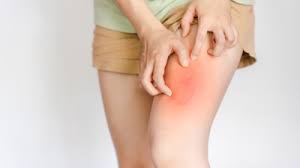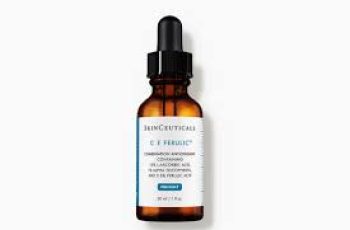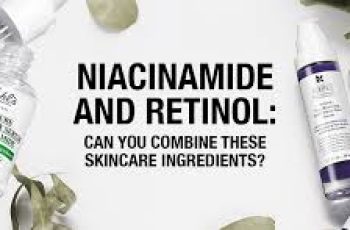7 Ways to Deal With Thigh Chafing, According to Dermatologists
The warm summer months are associated with many positive experiences: taking a refreshing dip at the pool or beach, grilling outside with friends and family, and soaking up much-needed vitamin D (covered in SPF, of course!). While warm weather has many benefits, its forecast is not exclusively sunny for your thighs, as one dreaded side effect of increased temperatures and humidity is thigh chafing.
Many (if not most) people will experience their thighs making contact when they walk or run. When skin makes contact with skin, there is the potential for friction and irritation. Certain factors, such as heat and humidity, can exacerbate the friction, making the irritation worse, known as chafing. To understand the best ways to protect your inner thigh skin, we turned to three skin experts: Board-certified dermatologists Dr. Marisa Garshick, Dr. Anna Guanche, and Dr. Rebecca Marcus. Keep reading for their seven tips for preventing thigh chafing.
01
of 07
Friction/Chafing Sticks
Dermatologist Dr. Rebecca Marcus explains that chafing occurs when friction disrupts the skin barrier on the thighs. “Friction may be a result of clothing rubbing against skin, thighs rubbing against one another, or sports, such as biking, that result in repeated, continuous motion of the thighs,” she says. One of the most commonly used anti-chafing products is friction or chafing sticks. These are usually glide-on products that work by reducing the friction between the skin.
Marcus recommends the Nakery Beauty Glide & Go Magic Friction Stick to help prevent chafing while treating minor irritation. “The Glide & Go Magic Friction Stick consists of a balm with a well-absorbed, silky, powder-like finish, allowing the skin to glide smoothly instead of rub. Skin-loving ingredients such as aloe, squalene, and jojoba wax soothe and heal skin while preventing further chafing,” Marcus explains.
Similarly, dermatologist Dr. Marisa Garshick recommends the Megababe Thigh Rescue, which she says has an easy-to-use formula that glides on easily and includes aloe and vitamin E to soothe the skin. Garshick also recommends the Gold Bond Friction Defense Stick as a great non-greasy and unscented option.
02
of 07
Barrier Creams
When looking for something to prevent chafing, Garshick says you are looking for something to create a barrier between the skin or tight clothing. For this reason, it can help to apply a barrier cream to minimize the potential for rubbing. Garshick recommends the Body Glide Anti-Chafe Balm, a fragrance-free balm that forms an invisible, dry barrier to protect the skin and can be applied to friction-prone areas, including the thighs, groin, neck, arms, feet, and chest.
Dermatologist Dr. Anna Guanche focuses on the moisture problem when it comes to tackling thigh chafing. “One of the best ways to prevent thigh chafing is to keep the area dry,” she explains. Guanche says you can reach for a baby powder, but her top recommendation is the MAELYS B-FOXY Inner Thigh Firming Cream. “This product has a powdery matte feel due to the tapioca starch that prevents chafing and additionally is proven to firm the skin,” Guanche explains.
03
of 07
Chafing Shorts or Shapewear
Chafing shorts have become a popular solution for under dresses and skirts. These are typically snug-fitting shorts (to prevent them from bunching or rolling up) made of materials like bamboo or spandex.
Moisture-wicking materials are best for keeping the area dry, Guanche explains. “Any sweat or moisture will cause the area to stick together, making any rubbing worse,” she says. You also don’t need to buy specifically branded chafing shorts either. Garshick says that certain types of shapewear can also prevent chafing if they have fabric covering the thigh.
04
of 07
Thigh Bands or Body Tape
Consider thigh bands or body tape if your outfit doesn’t allow you to wear shorts or if you want a physical barrier. If you’re not ready to invest in thigh bands, you can achieve a similar effect with body tape (also called boob tape) you already have on hand. Use strips of tape to cover the area of your thigh where chafing occurs. Be sure to carefully remove the tape, to avoid irritation. It’s also not a good idea to place tape over irritated or broken skin, so consider other solutions if chafing has already occurred.
05
of 07
Zinc-Based Cream
Diaper rash is not all that different than chafing: both are caused by moisture and friction. For this reason, Garshick recommends using a zinc-based diaper rash cream to protect against and treat thigh chafing. “While more often thought of for diaper rash, this zinc-based cream can also help to prevent chafing by serving as a barrier cream,” explains Garshick.
06
of 07
Deodorant
Garshick recommends using deodorant for chafing, especially if sweating exacerbates your issues. “If excess sweat is an issue, it may also be helpful to apply a gentle deodorant or antiperspirant to reduce overall moisture and odor from sweat buildup,” explains Garshick.
07
of 07
Thick Moisturizing Ointment
If you’ve already chafed your inner thighs, you need to be careful about what you apply to the irritated skin barrier. In these situations, Garshick recommends using thick, moisturizing ointments, such as Vaseline Healing Jelly or Aquaphor Healing Ointment to the area where chafing may occur to prevent and treat it, as it creates an occlusive barrier to protect the skin while allowing it to heal. Garshick does caution that if irritation persists or worsens, it’s best to consult a dermatologist, as topical steroid creams may be helpful depending on the extent of the irritation.
The Takeaway
Thigh chafing is caused by consistent skin-on-skin contact and friction of the inner thighs, and it typically worsens in the summer or during exercise because of sweat due to heat and humidity. Chafing can cause serious irritation, redness, and even skin blistering, so our experts agree that action must be taken at the first sign of pain or redness. Marcus recommends the proactive preventative application of anti-chafing products instead of waiting for irritation for comfy thighs this summer (and beyond).
DQH Knowledge drop: In your 20s, your skin cell turnover decreases. (Cell turnover is a key component in keeping your skin youthful.) You know what else slows down? Your collagen production. Starting in your 20s, collagen decreases by about 1 percent per year. Should you want to prevent fine lines and wrinkles, start by eliminating behaviors that contribute to premature aging. “If it’s bad for you, it’s bad for your skin,” says dermatologist Michel Somenek.
“Cigarette smoking reduces blood flow to the skin and causes premature wrinkling and a dull skin texture. Making the repeated pursed motion to inhale can also cause smoker’s lines. Alcohol and recreational drugs are toxins for the skin that damage its cellular structure and DNA,” Somenek tells us. “The faster you eliminate vices while you are young, the better chance your skin and body have to recuperate.” Also, adopting an anti-aging routine in your 20s is key. After all, the best offense is a good defense. We spoke to Somenek and experts Joshua Ross and Audrey Kunin to find out more.
Keep reading for the best anti-aging products for your 20s, according to skincare professionals.
Sunscreen
“We all know that the sun is the number one cause of skin aging and starting the prevention in your 20s is very important,” Ross says. “The majority of your sun damage won’t start to appear until you’re in your 30s, so don’t wait until you see it surface or you’ll be behind the curve. Stay ahead of it with a good-quality zinc-based sunscreen worn daily.”
Farmacy Green Defense Daily Mineral Sunscreen
An invisible sunscreen with SPF 30, plus botanical extracts meant to protect skin with tons of antioxidants. Bonus: It’s clean and fine to use under makeup.
Bareminerals Complexion Rescue™ Tinted Moisturizer Broad Spectrum SPF 30
Although we recommend you use your SPF and moisturizer separately, we also understand moments when you don’t have time or energy for that extra step. For those times, this bareMinerals moisturizer is a great thing to have on hand.
Vitamin C Serum
“A great introduction to anti-aging is to start with a vitamin C serum in your morning skincare routine,” Ross says. “It’s a powerful antioxidant that will neutralize free radicals and brighten the skin.” He adds that it’s a great way to counteract the effects of the sun’s harmful rays, which, as previously mentioned, are among the biggest causes of premature aging.
Drunk Elephant C-Firma™ Vitamin C Day Serum
The Drunk Elephant C-Firma is a lightweight serum that promises to give skin a glow by combining the brightening powers of vitamin C with ferulic acid, l-ascorbic acid, and vitamin E. The included sodium hyaluronate is meant to replace hydration loss, so you shouldn’t have to deal with any irritation.
Sunday Riley C.E.O. Rapid Flash Brightening Serum
This potent serum is jam-packed with vitamin C (15 percent, to be exact), which means it’s a potential superstar at both brightening skin and dousing it in antioxidants.
Peptides
Using peptides on your skin has many benefits, says Somenek. “The skin barrier is what defends the body against pollution, UV rays, bacteria, and toxins. It can be damaged by several everyday factors. Using topical peptides aids in building a stronger barrier,” he says. “Peptides comprise elastic fibers, which are a type of protein. These fibers help to make skin appear taut and firm. Peptides can also help repair damaged skin, relieve inflammation, and even out skin tone. Some peptides can kill acne-causing bacteria that is common in 20-somethings.”
Kunin agrees, saying, “Peptides are an excellent entry point for supporting collagen.” She recommends looking for face and eye treatments that contain these collagen-boosting powerhouses.
Charlotte Tilbury Magic Eye Rescue Cream
This Charlotte Tilbury super-emollient eye cream has a base of coconut oil and shea butter (read: it’s incredibly hydrating). Botanicals plus peptides are meant to help reduce dark circles and boost collagen, respectively.
This creamy moisturizer serves up potent collagen-boosting peptides and pycnogenol, and antioxidant-rich vitamin C. “Instead of sitting on top of the skin, peptides penetrate the outer layer so they go deep. The ‘signals’ they send tell the cells to produce elastin and collagen, which are needed for youthful-looking skin,” explains Somenek.
At-Home Peel Pads
Remember that skin cell turnover fiasco we talked about earlier? One way to help support it is by exfoliating. “Exfoliation is important to help keep skin fresh and luminous,” Kunin says. She recommends using at-home peel pads as an easy and effective way to exfoliate.
“The goal in your 20s is to fight the slowing pace of cell turnover. It is wise to use products that gently exfoliate, yet still remove oil and other impurities. Products that have Alpha Hydroxy Acids (AHA) or Beta Hydroxy Acids (BHA) are a good choice.”
According to Somenek, you should only exfoliate two to three times a week. “People of all ages are guilty of over-exfoliating and that can be too much of a good thing,” he says.
Dermadoctor Kakadu C Intensive Vitamin C Peel Pad
A few swipes of this Derma Doctor powerful peel pad promise to leave your skin glowing and smooth, thanks to the seven (yes, seven) types of chemical exfoliants, including AHA and BHA. It also contains vitamin C via Kakadu plum extract for added brightening and antioxidant protection.
KEY INGREDIENTS Kakadu plum extract is sourced from the Kakadu plum, a fruit grown in northern Australia. It contains vitamin C, which restores the skin’s natural barrier, increases collagen production, and soothes irritation.
Dr. Dennis Gross Skincare Alpha Beta® Universal Daily Peel Pads
These are the gold standard of peel pads, with a cult following and over 900 five-star reviews on Sephora. They’re easy to use and contain a blend of anti-aging exfoliating acids.
Emollient Night Cream
“In your 20s, you need to start upping the hydration in your skincare routine. You may have been cautious of over-moisturizing because of acne in your teens, but as you enter your 20s, your skin transitions and becomes drier,” Ross says. “I recommend an emollient night cream added into your evening skincare regimen.”
“Twenty-somethings need to make sure that they are not using creams that will clog their pores and cause excess oil production,” says Somenek. Opt for non-comedogenic products.
Cerave Skin Renewing Night Cream
One great choice is the CeraVe Skin Renewing Night Cream, which is a non-comedogenic night cream that leaves skin soft and glowy. It combines the moisturizing powers of ceramides and hyaluronic acid.
RoC Retinol Correxion Max Hydration Creme
“The best night cream ingredients contain retinol, benzoyl peroxide, and/or salicylic acid or hyaluronic acid. The goal is to moisturize, yet remove excess oil,” says Somenek. This Roc Retinol Correxion cream fits the bill as it contains both hyaluronic acid and retinol so it promises to moisturize while also being non-comedogenic.



